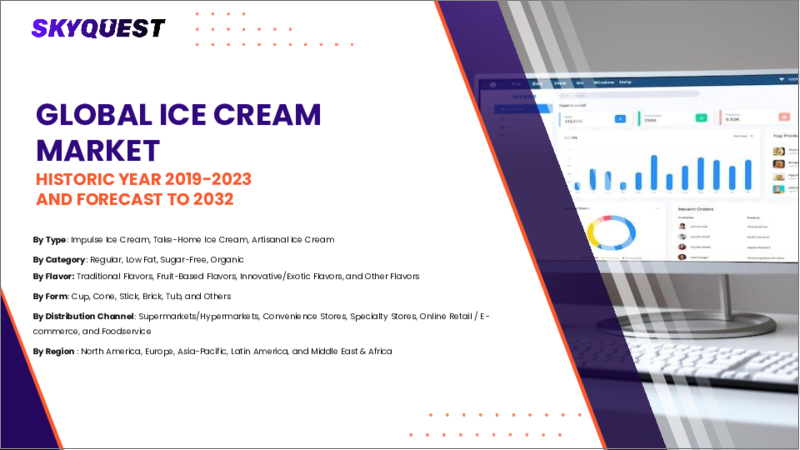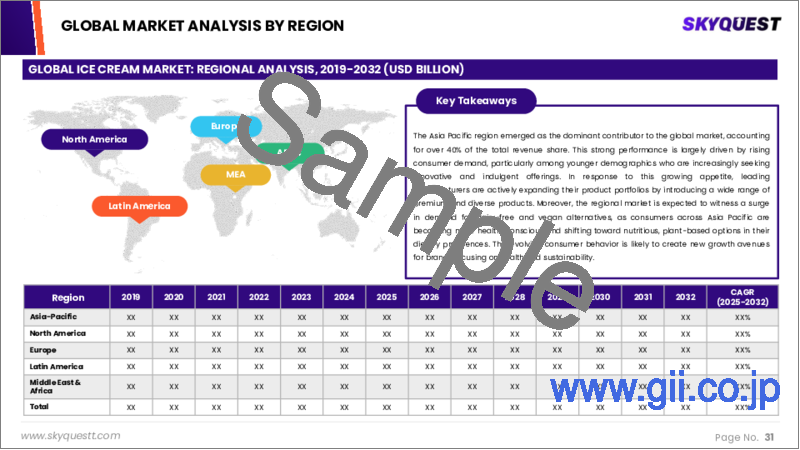|
|
市場調査レポート
商品コード
1610666
アイスクリームの市場規模、シェア、成長分析、タイプ別、フレーバー別、包装別、カテゴリー別、流通チャネル別、エンドユーザー別、地域別 - 産業予測、2024年~2031年Ice Cream Market Size, Share, Growth Analysis, By Type (Impulse Ice Cream, Take-Home Ice Cream), By Flavor, By Packaging, By Category, By Distribution Channel, By End User, By Region - Industry Forecast 2024-2031 |
||||||
|
|||||||
| アイスクリームの市場規模、シェア、成長分析、タイプ別、フレーバー別、包装別、カテゴリー別、流通チャネル別、エンドユーザー別、地域別 - 産業予測、2024年~2031年 |
|
出版日: 2024年12月10日
発行: SkyQuest
ページ情報: 英文 165 Pages
納期: 3~5営業日
|
全表示
- 概要
- 目次
世界のアイスクリームの市場規模は、2022年に736億1,000万米ドルとなり、2023年の783億9,000万米ドルから、2031年までには1,297億4,000万米ドルに成長し、予測期間(2024年~2031年)のCAGRは6.5%で推移する見通しです。
アイスクリーム市場は、ハード、ソフト、ライト、低脂肪アイスクリームなど多様な製品によって力強い成長を遂げています。これらの製品に本物の砂糖や人工甘味料を加えて甘くすることで、さまざまな消費者の選好に対応し、需要をさらに高めています。夏季は依然としてアイスクリーム消費の最盛期であり、主にプレミアム価格で市場収益を増大させる幅広いフレーバーがその原動力となっています。世界の動向は、ファストフードへの消費支出の増加と革新的製品のための広範な研究開発、アクセスの改善とが相まって、市場の拡大を促進することを示しています。さらに、新興国における都市化と可処分所得の増加が、今後数年間の業界の成長に大きく寄与すると予想されます。
目次
イントロダクション
- 調査の目的
- 調査範囲
- 定義
調査手法
- 情報調達
- 二次データと一次データの方法
- 市場規模予測
- 市場の前提条件と制限
エグゼクティブサマリー
- 世界市場の見通し
- 供給と需要の動向分析
- セグメント別機会分析
市場力学と見通し
- 市場概要
- 市場規模
- 市場力学
- 促進要因と機会
- 抑制要因と課題
- ポーター分析と影響
- 競争企業間の敵対関係
- 代替品の脅威
- 買い手の交渉力
- 新規参入業者の脅威
- 供給企業の交渉力
主要な市場の考察
- 主要な成功要因
- 競合の程度
- 主要な投資機会
- 市場エコシステム
- 市場の魅力指数(2023年)
- PESTEL分析
- マクロ経済指標
- バリューチェーン分析
- 価格分析
- 規制情勢
- 特許分析
- ケーススタディ
- 顧客と購買基準の分析
世界のアイスクリームの市場規模:タイプ別・CAGR(2024年~2031年)
- 市場概要
- インパルスアイスクリーム
- アイスクリームバー
- アイスクリームコーン
- アイスクリームサンドイッチ
- 持ち帰りアイスクリーム
- タブ型
- ブリックス
- ファミリーパック
- 職人技アイスクリーム
- ジェラート
- シャーベット
- フローズンヨーグルト
世界のアイスクリームの市場規模:フレーバー別・CAGR(2024年~2031年)
- 市場概要
- バニラ
- チョコレート
- フルーツフレーバー
- いちご
- マンゴー
- ミックスベリー
- その他のフレーバー
- クッキー&クリーム
- ミントチョコレートチップ
- コーヒー
世界のアイスクリームの市場規模:包装別・CAGR(2024年~2031年)
- 市場概要
- カップ
- コーン
- スティック
- ブリック
- タブ型
- その他の包装
- パウチ
- バー
世界のアイスクリームの市場規模:カテゴリー別・CAGR(2024年~2031年)
- 市場概要
- 乳製品アイスクリーム
- 乳製品以外のアイスクリーム
- ビーガンアイスクリーム
- 乳糖フリーアイスクリーム
世界のアイスクリームの市場規模:流通チャネル別・CAGR(2024年~2031年)
- 市場概要
- オフトレード
- スーパーマーケット
- コンビニエンスストア
- オンライン小売
- 専門小売業者
- その他
- オントレード
- レストラン
- カフェ
- アイスクリームパーラー
世界のアイスクリームの市場規模:エンドユーザー別・CAGR(2024年~2031年)
- 市場概要
- 子供たち
- 大人
- シニア
アイスクリーム市場規模・CAGR(2024年~2031年)
- 北米
- 米国
- カナダ
- 欧州
- 英国
- ドイツ
- スペイン
- フランス
- イタリア
- その他欧州地域
- アジア太平洋
- 中国
- インド
- 日本
- 韓国
- その他アジア太平洋
- ラテンアメリカ
- ブラジル
- その他ラテンアメリカ地域
- 中東・アフリカ
- GCC諸国
- 南アフリカ
- その他中東・アフリカ
競合情報
- 上位5社の比較
- 主要企業の市場ポジショニング(2023年)
- 主要な市場企業が採用した戦略
- 市場の最近の動向
- 企業の市場シェア分析(2023年)
- 主要企業の企業プロファイル
- 会社概要
- 製品ポートフォリオ分析
- 企業のセグメント別シェア分析
- 収益の前年比比較(2021年~2023年)
主要企業プロファイル
- Unilever
- Nestle
- General Mills(Haagen-Dazs)
- Blue Bell Creameries
- Lotte Confectionery
- Dairy Farmers of America Inc.
- Inner Mongolia Yili Industrial Group Co. Ltd
- Wells Enterprises Inc.
- FrieslandCampina
- Meiji Holdings Co., Ltd.
- Turkey Hill Dairy
- Froneri International Limited
- Dean Foods
- Amul(Gujarat Cooperative Milk Marketing Federation)
- Mars, Incorporated
- Baskin-Robbins
- Tillamook County Creamery Association
- Focus Brands LLC
- Gifford's Dairy Inc.
- Van Leeuwen Ice Cream
結論と提言
Global Ice Cream Market size was valued at USD 73.61 billion in 2022 and is poised to grow from USD 78.39 billion in 2023 to USD 129.74 billion by 2031, growing at a CAGR of 6.5% during the forecast period (2024-2031).
The ice cream market is experiencing robust growth, driven by diverse offerings such as hard, soft, light, and low-fat ice creams. The sweetening of these products with either real sugar or artificial sweeteners caters to various consumer preferences, further enhancing demand. The summer season remains the peak period for ice cream consumption, predominantly fueled by a wide range of flavors that command premium pricing and increase market revenues. Global trends indicate that rising consumer spending on fast food, coupled with extensive R&D for innovative products and improved accessibility, will propel market expansion. Furthermore, increased urbanization and disposable income in emerging economies are expected to significantly contribute to the industry's growth in the coming years.
Top-down and bottom-up approaches were used to estimate and validate the size of the Global Ice Cream market and to estimate the size of various other dependent submarkets. The research methodology used to estimate the market size includes the following details: The key players in the market were identified through secondary research, and their market shares in the respective regions were determined through primary and secondary research. This entire procedure includes the study of the annual and financial reports of the top market players and extensive interviews for key insights from industry leaders such as CEOs, VPs, directors, and marketing executives. All percentage shares split, and breakdowns were determined using secondary sources and verified through Primary sources. All possible parameters that affect the markets covered in this research study have been accounted for, viewed in extensive detail, verified through primary research, and analyzed to get the final quantitative and qualitative data.
Global Ice Cream Market Segmental Analysis
Global Ice Cream Market is segmented by type, flavor, packaging, category, distribution channel, end user and region. Based on type, the market is segmented into impulse ice cream, take-home ice cream and artisanal ice cream. Based on flavour, the market is segmented into vanilla, chocolate, fruit flavors, other flavors. Based on packaging, the market is segmented into cup, cone, stick, brick, tub and other packaging. Based on category, the market is segmented into dairy ice cream and non-dairy ice cream. Based on distribution channel, the market is segmented into off-trade and on-trade. Based on region, the market is segmented into North America, Europe, Asia Pacific, Latin America and Middle East & and Africa.
Driver of the Global Ice Cream Market
The global ice cream market is set to experience significant growth driven by various factors in the upcoming years. A notable rise in millennials' preference for convenient food options, coupled with increasing disposable income levels, is spurring demand. Consumers are increasingly drawn to diverse flavors, enhancing their overall experience. As per capita income rises, more individuals can indulge in premium ice cream products reflective of a luxurious lifestyle. Moreover, heightened consumer awareness about different brands, driven by urbanization and globalization, further propels market growth. Technological advancements have improved supply chains, allowing ice cream to remain fresher for longer, while targeted marketing strategies enhance brand visibility, attracting a larger customer base. Additionally, the introduction of healthier options, including lower-sugar variants, responds to the growing health consciousness among consumers, fostering further interest in the ice cream sector.
Restraints in the Global Ice Cream Market
The global ice cream market is likely to face several impediments to its growth. One significant challenge is the higher price points compared to competing products, which could deter potential consumers. Furthermore, the organic ice cream sector is expected to encounter difficulties due to stringent regulations regarding ingredient standardization. Ice cream, being a perishable frozen dairy item, typically has a shelf life of 2-3 months; improper storage can reduce this timeframe, thereby increasing storage costs and hindering market growth. Additionally, demand for ice cream tends to drop during winter and monsoon seasons, as its popularity peaks in summer, further complicating market expansion efforts.
Market Trends of the Global Ice Cream Market
The global ice cream market is witnessing a dynamic trend towards innovation, with producers focusing on functional ingredients, organic herbal inclusions, and exotic flavors to capture a broader consumer base. The rising inclination for unique taste experiences has led manufacturers to introduce enticing flavors such as coconut, lemon, and a variety of tropical fruits. To cater to health-conscious consumers, low-calorie and low-fat options like Skinny Cow are gaining popularity, further expanding their demographic reach. Additionally, favorable regulations stimulate market innovation, enabling companies to adapt swiftly to evolving consumer preferences and solidifying the growth trajectory of the global ice cream market.
Table of Contents
Introduction
- Objectives of the Study
- Scope of the Report
- Definitions
Research Methodology
- Information Procurement
- Secondary & Primary Data Methods
- Market Size Estimation
- Market Assumptions & Limitations
Executive Summary
- Global Market Outlook
- Supply & Demand Trend Analysis
- Segmental Opportunity Analysis
Market Dynamics & Outlook
- Market Overview
- Market Size
- Market Dynamics
- Driver & Opportunities
- Restraints & Challenges
- Porters Analysis & Impact
- Competitive rivalry
- Threat of substitute
- Bargaining power of buyers
- Threat of new entrants
- Bargaining power of suppliers
Key Market Insights
- Key Success Factors
- Degree of Competition
- Top Investment Pockets
- Market Ecosystem
- Market Attractiveness Index, 2023
- PESTEL Analysis
- Macro-Economic Indicators
- Value Chain Analysis
- Pricing Analysis
- Regulatory Landscape
- Patent Analysis
- Case Studies
- Customer & Buying Criteria Analysis
Global Ice Cream Market Size by Type & CAGR (2024-2031)
- Market Overview
- Impulse Ice Cream
- Ice Cream Bars
- Ice Cream Cones
- Ice Cream Sandwiches
- Take-Home Ice Cream
- Tubs
- Bricks
- Family Packs
- Artisanal Ice Cream
- Gelato
- Sorbet
- Frozen Yogurt
Global Ice Cream Market Size by Flavor & CAGR (2024-2031)
- Market Overview
- Vanilla
- Chocolate
- Fruit Flavors
- Strawberry
- Mango
- Mixed Berry
- Other Flavors
- Cookies and Cream
- Mint Chocolate Chip
- Coffee
Global Ice Cream Market Size by Packaging & CAGR (2024-2031)
- Market Overview
- Cup
- Cone
- Stick
- Brick
- Tub
- Other Packaging
- Pouches
- Bars
Global Ice Cream Market Size by Category & CAGR (2024-2031)
- Market Overview
- Dairy Ice Cream
- Non-Dairy Ice Cream
- Vegan Ice Cream
- Lactose-Free Ice Cream
Global Ice Cream Market Size by Distribution Channel & CAGR (2024-2031)
- Market Overview
- Off-Trade
- Supermarkets
- Convenience Stores
- Online Retail
- Specialist Retailers
- Others
- On-Trade
- Restaurants
- Cafes
- Ice Cream Parlors
Global Ice Cream Market Size by End User & CAGR (2024-2031)
- Market Overview
- Children
- Adults
- Seniors
Global Ice Cream Market Size & CAGR (2024-2031)
- North America, (Type, Flavor, Packaging, Category, Distribution Channel, End User)
- US
- Canada
- Europe, (Type, Flavor, Packaging, Category, Distribution Channel, End User)
- UK
- Germany
- Spain
- France
- Italy
- Rest of Europe
- Asia-Pacific, (Type, Flavor, Packaging, Category, Distribution Channel, End User)
- China
- India
- Japan
- South Korea
- Rest of Asia Pacific
- Latin America, (Type, Flavor, Packaging, Category, Distribution Channel, End User)
- Brazil
- Rest of Latin America
- Middle East & Africa, (Type, Flavor, Packaging, Category, Distribution Channel, End User)
- GCC Countries
- South Africa
- Rest of Middle East & Africa
Competitive Intelligence
- Top 5 Player Comparison
- Market Positioning of Key Players, 2023
- Strategies Adopted by Key Market Players
- Recent Developments in the Market
- Company Market Share Analysis, 2023
- Company Profiles of All Key Players
- Company Details
- Product Portfolio Analysis
- Company's Segmental Share Analysis
- Revenue Y-O-Y Comparison (2021-2023)
Key Company Profiles
- Unilever
- Company Overview
- Business Segment Overview
- Financial Updates
- Key Developments
- Nestle
- Company Overview
- Business Segment Overview
- Financial Updates
- Key Developments
- General Mills (Haagen-Dazs)
- Company Overview
- Business Segment Overview
- Financial Updates
- Key Developments
- Blue Bell Creameries
- Company Overview
- Business Segment Overview
- Financial Updates
- Key Developments
- Lotte Confectionery
- Company Overview
- Business Segment Overview
- Financial Updates
- Key Developments
- Dairy Farmers of America Inc.
- Company Overview
- Business Segment Overview
- Financial Updates
- Key Developments
- Inner Mongolia Yili Industrial Group Co. Ltd
- Company Overview
- Business Segment Overview
- Financial Updates
- Key Developments
- Wells Enterprises Inc.
- Company Overview
- Business Segment Overview
- Financial Updates
- Key Developments
- FrieslandCampina
- Company Overview
- Business Segment Overview
- Financial Updates
- Key Developments
- Meiji Holdings Co., Ltd.
- Company Overview
- Business Segment Overview
- Financial Updates
- Key Developments
- Turkey Hill Dairy
- Company Overview
- Business Segment Overview
- Financial Updates
- Key Developments
- Froneri International Limited
- Company Overview
- Business Segment Overview
- Financial Updates
- Key Developments
- Dean Foods
- Company Overview
- Business Segment Overview
- Financial Updates
- Key Developments
- Amul (Gujarat Cooperative Milk Marketing Federation)
- Company Overview
- Business Segment Overview
- Financial Updates
- Key Developments
- Mars, Incorporated
- Company Overview
- Business Segment Overview
- Financial Updates
- Key Developments
- Baskin-Robbins
- Company Overview
- Business Segment Overview
- Financial Updates
- Key Developments
- Tillamook County Creamery Association
- Company Overview
- Business Segment Overview
- Financial Updates
- Key Developments
- Focus Brands LLC
- Company Overview
- Business Segment Overview
- Financial Updates
- Key Developments
- Gifford's Dairy Inc.
- Company Overview
- Business Segment Overview
- Financial Updates
- Key Developments
- Van Leeuwen Ice Cream
- Company Overview
- Business Segment Overview
- Financial Updates
- Key Developments





